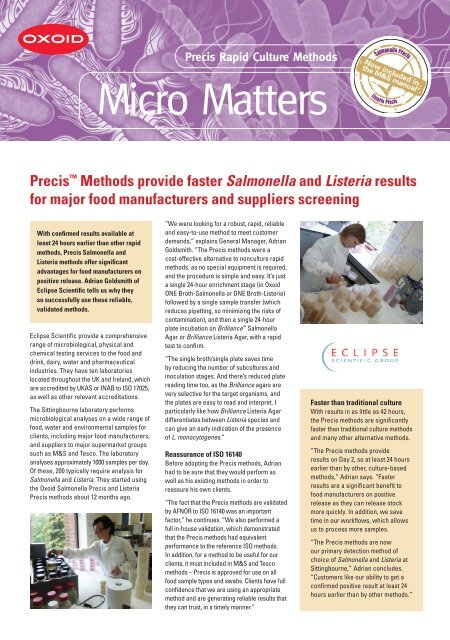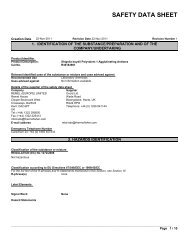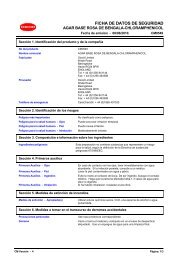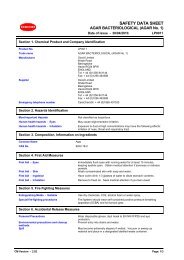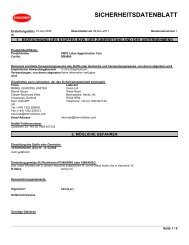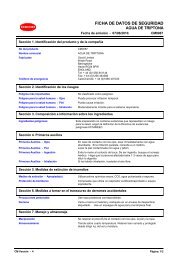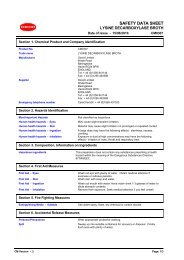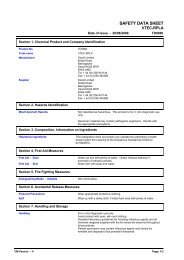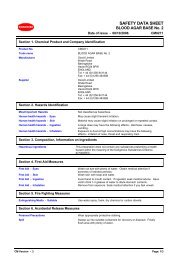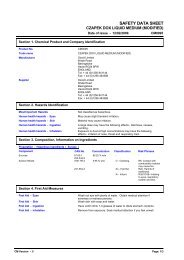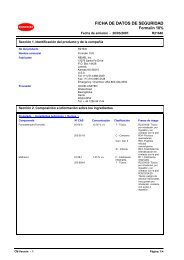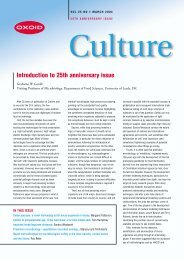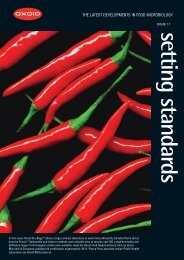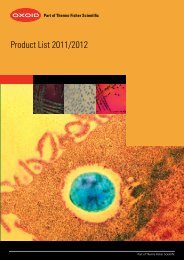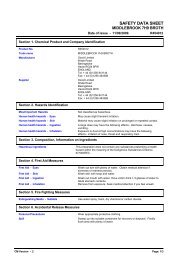Precis Rapid Culture Methods - Oxoid
Precis Rapid Culture Methods - Oxoid
Precis Rapid Culture Methods - Oxoid
You also want an ePaper? Increase the reach of your titles
YUMPU automatically turns print PDFs into web optimized ePapers that Google loves.
Eclipse Scientifi c provide a comprehensive<br />
range of microbiological, physical and<br />
chemical testing services to the food and<br />
drink, dairy, water and pharmaceutical<br />
industries. They have ten laboratories<br />
located throughout the UK and Ireland, which<br />
are accredited by UKAS or INAB to ISO 17025,<br />
as well as other relevant accreditations.<br />
The Sittingbourne laboratory performs<br />
microbiological analyses on a wide range of<br />
food, water and environmental samples for<br />
clients, including major food manufacturers,<br />
and suppliers to major supermarket groups<br />
such as M&S and Tesco. The laboratory<br />
analyses approximately 1000 samples per day.<br />
Of these, 200 typically require analysis for<br />
Salmonella and Listeria. They started using<br />
the <strong>Oxoid</strong> Salmonella <strong>Precis</strong> and Listeria<br />
<strong>Precis</strong> methods about 12 months ago.<br />
<strong>Precis</strong> <strong>Rapid</strong> <strong>Culture</strong> <strong>Methods</strong><br />
Micro Matters<br />
<strong>Precis</strong> <strong>Methods</strong> provide faster Salmonella and Listeria results<br />
for major food manufacturers and suppliers screening<br />
With confi rmed results available at<br />
least 24 hours earlier than other rapid<br />
methods, <strong>Precis</strong> Salmonella and<br />
Listeria methods offer signifi cant<br />
advantages for food manufacturers on<br />
positive release. Adrian Goldsmith of<br />
Eclipse Scientifi c tells us why they<br />
so successfully use these reliable,<br />
validated methods.<br />
“We were looking for a robust, rapid, reliable<br />
and easy-to-use method to meet customer<br />
demands,” explains General Manager, Adrian<br />
Goldsmith. “The <strong>Precis</strong> methods were a<br />
cost-effective alternative to nonculture rapid<br />
methods, as no special equipment is required,<br />
and the procedure is simple and easy. It’s just<br />
a single 24-hour enrichment stage (in <strong>Oxoid</strong><br />
ONE Broth-Salmonella or ONE Broth-Listeria)<br />
followed by a single sample transfer (which<br />
reduces pipetting, so minimizing the risks of<br />
contamination), and then a single 24-hour<br />
plate incubation on Brilliance Salmonella<br />
Agar or Brilliance Listeria Agar, with a rapid<br />
test to confi rm.<br />
“The single broth/single plate saves time<br />
by reducing the number of subcultures and<br />
inoculation stages. And there’s reduced plate<br />
reading time too, as the Brilliance agars are<br />
very selective for the target organisms, and<br />
the plates are easy to read and interpret. I<br />
particularly like how Brilliance Listeria Agar<br />
differentiates between Listeria species and<br />
can give an early indication of the presence<br />
of L. monocytogenes.”<br />
Reassurance of ISO 16140<br />
Before adopting the <strong>Precis</strong> methods, Adrian<br />
had to be sure that they would perform as<br />
well as his existing methods in order to<br />
reassure his own clients.<br />
“The fact that the <strong>Precis</strong> methods are validated<br />
by AFNOR to ISO 16140 was an important<br />
factor,” he continues. “We also performed a<br />
full in-house validation, which demonstrated<br />
that the <strong>Precis</strong> methods had equivalent<br />
performance to the reference ISO methods.<br />
In addition, for a method to be useful for our<br />
clients, it must included in M&S and Tesco<br />
methods – <strong>Precis</strong> is approved for use on all<br />
food sample types and swabs. Clients have full<br />
confi dence that we are using an appropriate<br />
method and are generating reliable results that<br />
they can trust, in a timely manner.”<br />
Faster than traditional culture<br />
With results in as little as 42 hours,<br />
the <strong>Precis</strong> methods are signifi cantly<br />
faster than traditional culture methods<br />
and many other alternative methods.<br />
“The <strong>Precis</strong> methods provide<br />
results on Day 2, so at least 24 hours<br />
earlier than by other, culture-based<br />
methods,” Adrian says. “Faster<br />
results are a signifi cant benefi t to<br />
food manufacturers on positive<br />
release as they can release stock<br />
more quickly. In addition, we save<br />
time in our workfl ows, which allows<br />
us to process more samples.<br />
“The <strong>Precis</strong> methods are now<br />
our primary detection method of<br />
choice of Salmonella and Listeria at<br />
Sittingbourne,” Adrian concludes.<br />
“Customers like our ability to get a<br />
confi rmed positive result at least 24<br />
hours earlier than by other methods.”
See how easy the methods are to use<br />
DEDICATED TO MICROBIOLOGY<br />
Protocol for Listeria <strong>Precis</strong> Method<br />
Day 0: Enrichment<br />
25g or 25mL of sample + 225mL ONE Broth-Listeria<br />
Incubate for 24 ± 2 hours at 30°C<br />
Day 1: Plating<br />
Using a 10µL microbiological loop inoculate<br />
a single Brilliance Listeria plate.<br />
Incubate for 22–26 hours at 37°C<br />
(for meat samples<br />
re-incubate plates that<br />
show no blue colonies<br />
with halos for a further<br />
22–26 hours at 37°C)<br />
Select green-blue<br />
colonies with halos<br />
for confirmation<br />
Day 2: Results<br />
If present, confirm blue/green colonies with halos as<br />
L. monocytogenes using the O.B.I.S. mono test. Alternatively,<br />
confirm using standard ISO methods.**<br />
**If there is insufficient material to carry out an O.B.I.S. mono test, or if a mixed culture of<br />
L. monocytogenes and other Listeria species is suspected, first purify suspect colonies by sub-culture<br />
onto a second Brilliance Listeria plate.<br />
With today’s demands for faster results to pathogen testing in food and environmental samples, <strong>Precis</strong> Listeria and Salmonella methods, give<br />
your laboratory substantial time and labour savings compared to the traditional ISO methods. Validated by AFNOR to the ISO 16140 standard and<br />
recently included in the M&S manual, these methods require just one broth and one plate, followed by confi rmation. With minimal<br />
hands-on time, they provide results in just 2 days. To improve workfl ow and maximize your effi ciency, put your trust in the <strong>Precis</strong> methods.<br />
For more information about these products, please visit www.oxoid.com<br />
<strong>Oxoid</strong> and Remel are specialty microbiology brands of Thermo Fisher Scientifi c. Our products are available worldwide.<br />
www.oxoid.com<br />
Tel: +44 (0) 1256 841144<br />
oxoid.info@thermofi sher.com<br />
© 2011, Thermo Fisher Scientifi c Inc. All trademarks are the property of Thermo Fisher Scientifi c, Inc. and its subsidiaries.<br />
Copyright to photos held separately. All rights reserved.<br />
Protocol for Salmonella <strong>Precis</strong> Method<br />
Day 0: Enrichment<br />
25g or 25mL of sample + 225mL ONE Broth-Salmonella<br />
Incubate for 16–20 hours at 42°C<br />
Day 1: Plating<br />
Using a 10µL microbiological loop inoculate a single<br />
Brilliance Salmonella plate. Incubate for 22–26 hours at 37°C.<br />
Brilliance Salmonella Agar incorporates novel Inhibigen<br />
technology which improves Salmonella recovery by<br />
reducing background flora.<br />
Day 2: Results<br />
If present, select a well isolated purple coloured colony and test<br />
using the <strong>Oxoid</strong> Salmonella Latex Test. Alternatively, confirm<br />
purple colonies using standard ISO methods.<br />
Select purple colonies for confirmation<br />
Part of Thermo Fisher Scientifi c<br />
Folio No LT1460A/MS/08/11


